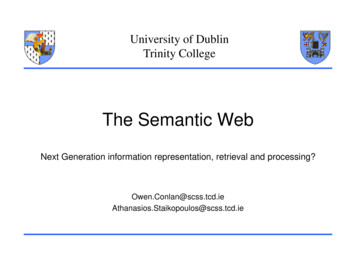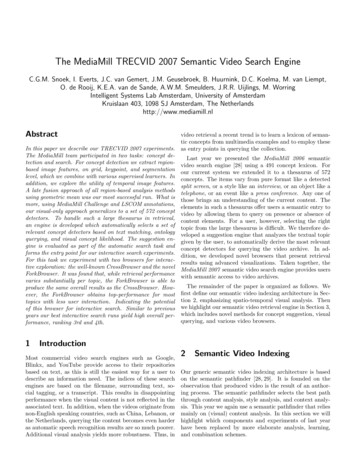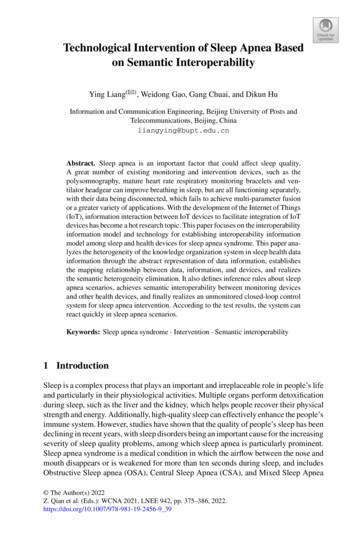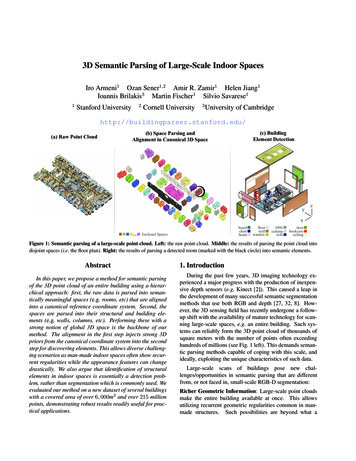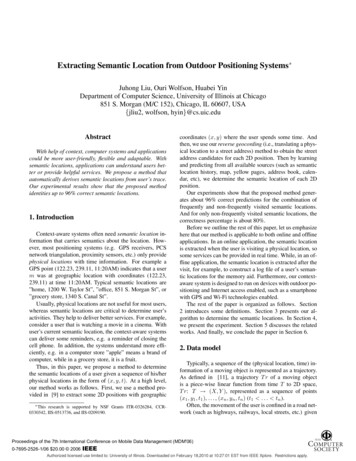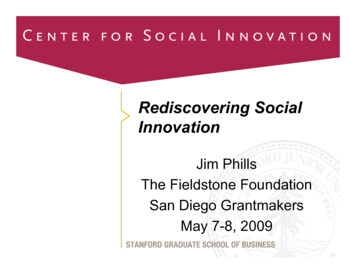
Transcription
Rediscovering SocialInnovationJim PhillsThe Fieldstone FoundationSan Diego GrantmakersMay 7-8, 2009
Rediscovering Social Innovation
The Proliferation of “Social” Stuff Penetration of business ideas, managementpractices, and market principles into the worldof and nonprofits and government Juxtaposing private sector concepts with theword “social” as a modifier–––––social entrepreneurshipsocial enterprisesocial venturesocial capitalistsocial innovation
Limitations of Social Entrepreneurship The Parable of the three blind men andthe elephantThis Is Social Entrepreneurship
Limitations of Social Entrepreneurship Can the Nobel prize Committee be wrong?– Muhammad Yunus– Grameen Bank– Microfinance
Limitations of Social EntrepreneurshipThe Big PictureSocial EnterpriseSocial al CapitalMarket
Limitations of Social Entrepreneurship Focus on individual level attributes &traits– Boldness, accountability, and risk-taking Emphasizes the creation of neworganizations Typically limited to nonprofit entities
Limitations of Social Entrepreneurship But isn’t focus a good thing? In this instance, No! because – Underlying concern is the creation of socialvalue by solving social problems– Social entrepreneurship is not the only, andcertainly not always the best way to achievethese goals
The Meaning of Social Innovation “Innovation”– Novelty– Performance improvement– Magnitude– Implementation/Adoption
The Meaning of Social Innovation “Social”– Social needs or problems– Social value– Balance in creation and capture of valuefavors the public
The Meaning of Social Innovation Any novel and useful solution to a socialneed or problem, that is better thanexisting approaches (i.e., more effective,efficient, sustainable, or just) and forwhich the value created (benefits)accrues primarily to society as a wholerather than private individuals
Examples of Social Innovation Microfinance Fair Trade Products
Mechanisms of Social Innovation Exchange of ideas and values between public, private,and nonprofit sectors– Socially Responsible Investing Shifting roles and relationships between businessgovernment and nonprofits– Emissions Trading Blending of market-based principles and mechanismswith public and philanthropic support.– Affordable home ownership and secondary mortgage market“Dissolving Boundaries”
Implications For Thought Leaders Develop conceptions of the phenomenonthat are clear and precise Distinguishing the processes throughwhich social innovations emerge, diffuse,and succeed (or fail)– These need to be seen as distinct rather thanconflated with our definitions
Implications For Context Shapers Nurture and support policies andpractices that foster the flow of ideas,values, capital, and talent across sectorboundaries– “Dissolving boundaries”
Implications For Social Innovators Importance of understanding, embracing,and leveraging these cross-sectordynamics and interaction
Postscript: A Victory for SocialInnovation President Obama’s Office of SocialInnovation Congress’ Edward M. Kennedy ServeAmerica Act 31 March 2009– Social Innovation Funds Pilot Program
Congressional Social Innovation Fund Objectives– Leverag[ing] Federal investments to increase State,local, business, and philanthropic resources toreplicate and expand proven solutions.– Increas[ing] private and public investment [to] allow[effective] organizations to replicate and expandproven initiatives or support new initiatives;– Seeding experimental initiatives focused onimproving outcomes– Strengthen[ing] the infrastructure to identify, investin, replicate, and expand initiatives with effectivesolutions to national and local challenges.
Some Friendly Amendments Social innovation fund, explicitly limits itsscope to " social entrepreneurs and other[italics added] nonprofit communityorganizations” This constrains the sources and kinds ofinnovative solutions to social problemswe can produce
Some Friendly Amendments There are those who believe that socialentrepreneurs should by definition be nonprofit.I don’t share that view. Many people intraditional larger nonprofits have taken offenseat the notion that you are a social entrepreneuronly if you’re new. In truth, a lot of people havecommitted themselves to social change andhave done great work. They should all becelebrated and seen as partners in the largerstruggle.– David Gergen, in SSIR September 2009
References Abernathy, William J., and James M. Utterback. "Patterns of Industrial Innovation." Technology Review 80, no. 7 (1978): 40-47.Amabile, T. M. "A Model of Creativity and Innovation in Organizations." In Research in Organizational Behavior, edited by Barry M.Staw and L. L. Cummings, 123-67. Greenwich, CT: JAI Press, 1988.Armendáriz de Aghion, Beatriz, and Jonathan Morduch. The Economics of Microfinance. Cambridge, MA: The MIT Press, 2005.Bornstein, David. How to Change the World: Social Entrepreneurs and the Power of New Ideas. New York: Oxford University Press,2004.Burns, Tom, and George M. Stalker. The Management of Innovation. London: Tavistock, 1961.Christensen, Clayton M. The Innovator's Dilemma: When New Technologies Cause Great Firms to Fail, Management of Innovationand Change Series. Boston, MA: Harvard Business School Press, 1997.Christensen, Clayton M., Heiner Baumann, Rudy Ruggles, and Thomas M. Sadtler. "Disruptive Innovation for Social Change."Harvard Business Review 84, no. 12 (2006): 94-101.Collins, James C. Good to Great and the Social Sectors: A Monograph to Accompany Good to Great. 1st ed. Boulder, CO: JimCollins, 2005.Cowen, Tyler. "Public Goods and Externalities: Old and New Perspectives." In Public Goods and Market Failures : A CriticalExamination, edited by Tyler Cowen, 1-26. New Brunswick (U.S.A.): Transaction Publishers, 1992.———. Public Goods and Market Failures : A Critical Examination. New Brunswick (U.S.A.): Transaction Publishers, 1992.Datar, Srikant M., Marc J. Epstein, and Kristi Yuthas. "In Microfinance, Clients Must Come First." Stanford Social Innovation Review 6,no. 1 (2008): 38-45.Dees, J. Gregory. "Enterprising Nonprofits." Harvard Business Review 76 (1998).———. "The Meaning of Social Entrepreneurship." Duke University, Fuqua School of Business,Emerson, Jed, and Fay Twersky. "New Social Entrepreneurs:The Success, Challenge and Lessons of Non-Profit EnterpriseCreation.". San Francisco: The Roberts Foundation, 1996.European Fair trade Association. "Fair Trade Yearbook 2001." a/yb.php.
References Ford Foundation. "Self-Help, Ford Foundation, Bank of America, Chevy Chase Bank and Fannie Mae Announce Successful Completion of 2 Billion Homeownership Initiative: Additional 2.5 Billion Pledged to Serve Another 35,000 Families." .Gartner, William B. ""Who Is an Entrepreneur?" Is the Wrong Question." American Journal of Small Business 12, no. 4 (19888): 11-32.Geczy, Christopher C., Robert F. Stambaugh, and David Levin. "Investing in Socially Responsible Mutual Funds." SSRN %R10.2139/ssrn.416380, http://ssrn.com/paper 416380Gore, Albert, Patrick Davidson Murray, and National Performance Review (U.S.). Reinventing Government-- by the People. Washington,D.C.: National Performance Review : For sale by the U.S. G.P.O. Supt. of Docs., 1994.Kanter, Rosabeth M. The Change Masters: Innovation and Entrepreneurship in the American Corporation. New York: Simon andSchuster, 1983.Kimberly, John R. "Managerial Innovation." In Handbook of Organizational Design, edited by Paul C. Nystrom and William H. Starbuck.New York: Oxford University Press, 1981.Light, Paul. "Searching for Social Entrepreneurs: Who They Might Be, Where They Might Be Found, What They Do." In Research onSocial Entrepreneurship: Understanding and Contributing to an Emerging Field: Arnova’s Occasional Paper Series, edited by RachelMosher-Williams, 13-37. Washington, DC: Association for Research on Nonprofit and Voluntary Organizations, 2006.Martin, Roger L., and Sally Osberg. "Social Entrepreneurship: The Case for Definition." Stanford Social Innovation Review 5, no. 2 (2007):28-39.McMillan, John. Reinventing the Bazaar: A Natural History of Markets. New York: W.W. Norton, 2002.McMillan, John, and David Hanley. "Grameen Bank." In SM116. Stanford, CA: Stanford Graduate School of Business, 2003.Moore, Mark Harrison. Creating Public Value: Strategic Management in Government Cambridge, Mass: Harvard University Press, 1995.Mosher-Williams, Rachel, ed. Research on Social Entrepreneurship: Understanding and Contributing to an Emerging Field. Vol. 1 (3),Arnova’s Occasional Paper Series. Washington, DC: Association for Research on Nonprofit and Voluntary Organizations, 2006.
References Oster, Sharon, Cynthia Massarsky, and Samantha Beinhacker, eds. Generating and Sustaining Nonprofit Earned Income: A Guide toSuccessful Enterprise Strategies. San Francisco: Jossey-Bass, 2004.Phills, James A, and Lyn Denend. "Social Entreprenuers: Correcting Market Failures (a)." In SI-72. Stanford, CA: Stanford GraduateSchool of Business, 2005.Mosher-Williams, Rachel, ed. Research on Social Entrepreneurship: Understanding and Contributing to an Emerging Field. Vol. 1 (3),Arnova’s Occasional Paper Series. Washington, DC: Association for Research on Nonprofit and Voluntary Organizations, 2006.Oster, Sharon, Cynthia Massarsky, and Samantha Beinhacker, eds. Generating and Sustaining Nonprofit Earned Income: A Guide toSuccessful Enterprise Strategies. San Francisco: Jossey-Bass, 2004.Phills, James A, and Lyn Denend. "Social Entreprenuers: Correcting Market Failures (a)." In SI-72. Stanford, CA: Stanford GraduateSchool of Business, 2005.Rogers, Everett M. Diffusion of Innovations. 5th ed. New York: Free Press, 2003.Schumpeter, Joseph Alois. Capitalism, Socialism and Democracy. New York: Harper, 1950/1942.Self-Help. "Self-Help Secondary Market." http://www.self-help.org/secondary-market.Social funds. "Introduction to Socially Responsible Investing." Social Investment Forum. "2005 Report on Socially Responsible Investing Trends in the United States." Washington, DC, 2006.Soule, Sarah A. "The Diffusion of an Unsuccessful Innovation: The Case of the Shantytown Protest Tactic." The Annals of the AmericanAcademy of Political and Social Science 566, no. November (1999): 120-31.Stanford Social Innovation Review. "Editor's Note." 1, no. 1 (2003): 4-5.Tushman, Michael, and Charles A. O'Reilly. Winning through Innovation: A Practical Guide to Leading Organizational Change andRenewal. Boston, MA: Harvard Business School Press, 1997.von Hippel, Eric. The Sources of Innovation. New York: Oxford, 1988.Wang, Randy. "The Blind Men and the Elephant." http://www.cs.princeton.edu/ rywang/berkeley/258/parable.html.Wikipedia. "Socially Responsible Investing." http://en.wikipedia.org/wiki/Socially responsible investing.Wolf, Charles Jr. Markets or Government: Choosing between Imperfect Alternatives. 2nd ed. Cambridge, MA: MIT Press, 1993.Yunus, Muhammad. Banker to the Poor: Micro-Lending and the Battle against World Poverty. New York: Public Affairs, 2003.
Penetration of business ideas, management practices, and market principles into the world of and nonprofits and government Juxtaposing private sector concepts with the word "social" as a modifier -social entrepreneurship - social enterprise -social venture -social capitalist -social innovation


